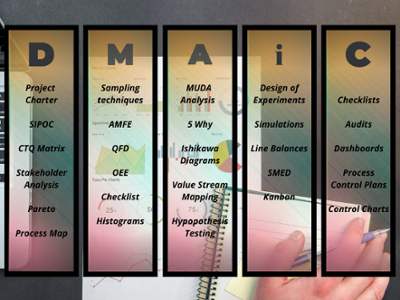DMAIC: Make continuous improvement of your processes a reality
“Life is a process”.If you think about it, it doesn't take too much philosophizing to realize that this is so. Life is a process.
Imagine you have a cake factory, you already have a defined brand, and your customers buy from you expecting to receive a product of the same size, with the same flavor and at the same price as always. However, for some reason, sometimes your cakes taste a little different, the decoration does not stick well, the size varies by a few millimeters, or the texture is not ideal. You can't sell the cakes that don't meet the specifications and you must see what you can do with them. Your process is standardized, so you follow the recipe to the letter and yet you don't know why these things happen.
Good thing you made it to this blog, where I'll teach you the DMAIC methodology to decrease those little variations. Whether you make cakes, pills, screws, or beers, I'll show you how this methodology helps you improve your processes and reduce waste.
INDEX
Before we can talk about DMAIC, we have to talk about Six Sigma. It is a work philosophy focused on continuous improvement, because it is designed so that companies are always looking for ways to improve. Its method consists of identifying and reducing the sources of variation, that is, maximizing and optimizing standardization so that the outputs of your processes are as similar as possible.
This is achieved from two approaches, the first is statistical, from which data is taken to evaluate the current state and progress. In general, companies tend to use averages to measure the performance of their operations. This is not bad, however, when we want to reduce the number of errors this variable gives us little information. On the other hand, sigma is another statistical variable that corresponds to variance, although in practical matters, and because it is impossible to measure all the pieces produced, it is used to refer to standard deviation, which refers to the quantification of the dispersion of your measurements from the mean, that is, how much the size of each cake is separated from the ideal average size of the cakes, for example. Taking a process to six sigma, i.e., six standard deviations, means that, for every million cakes, only 3.4 will come out different. That is right, 3.4 errors for every million attempts!
The second approach can be seen as the strategic one, since, being a philosophy of life, it must become a habit and habits are kept by discipline. Changing the mindset of your company so that your employees are always questioning what could cause problems, what could be done better or why things are being done as they are; means that they now have a mind focused on continuous improvement and therefore will be able to create strategies to reduce waste and errors in both manufacturing and service.
And what does this have to do with DMAIC? Well, Six Sigma is the philosophy and theory, DMAIC is a methodology that uses Six Sigma to achieve this goal.
I recommend you this blog to read a little more about how you can combine Six Sigma with other methodologies and also to discover some useful tools to leverage its results: Secret Tool for a Better Customer Journey Map: Lean Six Sigma

DMAIC is a problem-solving methodology to ensure quality improvement, which is focused on the study of processes. In simple terms this means that it is a method to observe a series of activities, identify in them possible causes of error, study them, propose and implement solutions to solve the problem and finally establish mechanisms to monitor the changes and guarantee that the errors do not happen again. Now that you understand, it sounds simple, doesn't it?
The truth is that DMAIC is the acronym for this methodology, which consists of the phases that I explain below:
A related article: DMAIC – A Beginner’s Guide
It is important to note that there are different tools that will help you in each phase, although each one has its contribution depending on the nature of the project, many are of general use and in fact can be repeated in some stages. In addition, research continues to develop updated tools that you could look for, for now, here is a list of some of the most common ones.

First let's remember that DMAIC is a methodology based on process improvement so, to apply it correctly, we must focus on processes. I think it is better to mention where it is not correct or necessary to use it, for example, where the solutions to the root causes are very obvious and do not deserve a very complex system to implement them; where there is no process management system already defined, because the implemented improvements might not be controlled; it will not be a good tool either if you have problems with the leadership and commitment of the top and middle management of your business, since they are in charge of transmitting the safety, value and objective of this type of projects to the rest of the company. Without the support of the latter, there could be resistance to change on the part of the collaborators, which would end up sabotaging the project before it even begins.
As for where to use it, there are several options:
It seems to me that the most important is to reduce the variation of your processes, reaching that level of standardization means a great achievement for any company, you are doing things better. On the other hand, implementing the discipline should also be considered a competitive advantage, as there are companies that have never thought of changing their current methodologies and therefore become outdated or obsolete.
These two approaches add value to your operations, which means you are improving quality, and by doing so your brand gains reputation with your customers. In addition to helping, you solve problems in your company, there are some associated benefits you might want to consider:
I recommend you to visit my blog “Improve Your Customer Journey Map with Six Sigma” as I talk a bit more about Six Sigma, standardization and DMAIC, but I explain how you can combine it with another tool (the Customer Journey Map) to improve the services you offer to your customers.


“Life is a process”.If you think about it, it doesn't take too much philosophizing to realize that this is so. Life is a process.

If your goal is to improve a process, the first thing you must do is understand it. To do this, you need to get the information, define the step by...

The manufacturing industry constantly faces challenges in its production processes that can affect efficiency, quality, and profitability.